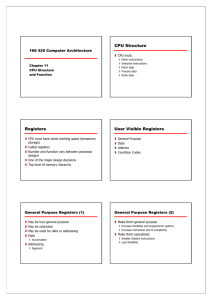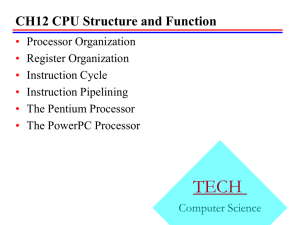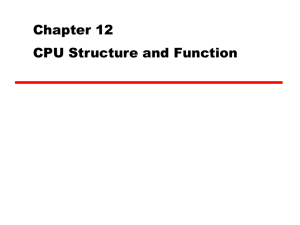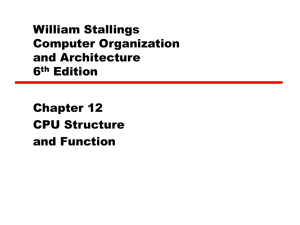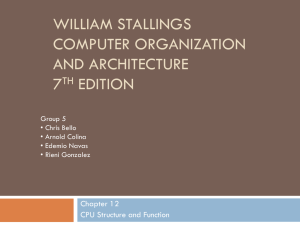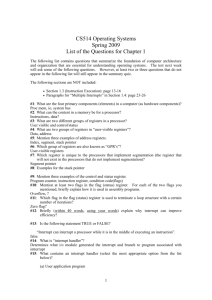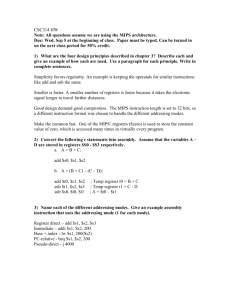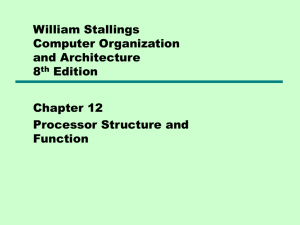12 Processor Structure and Function
advertisement
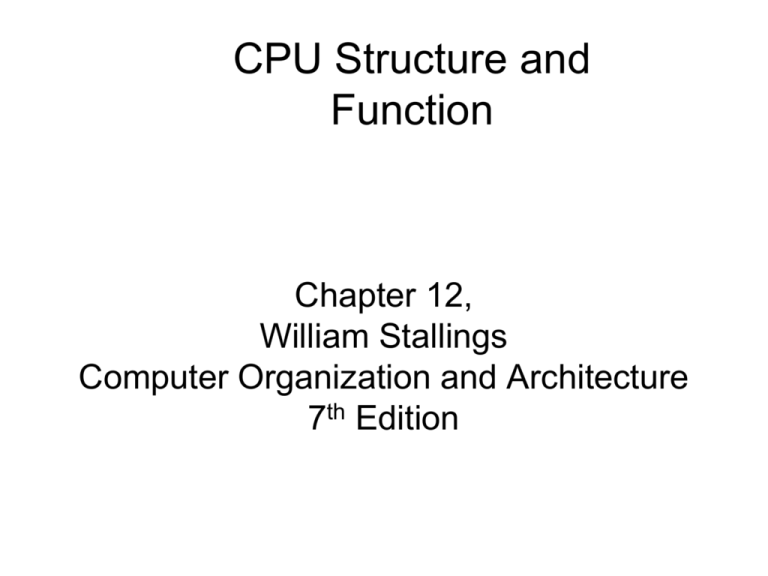
CPU Structure and Function Chapter 12, William Stallings Computer Organization and Architecture 7th Edition CPU Function • CPU must: – Fetch instructions – Interpret/decode instructions – Fetch data – Process data – Write data CPU With Systems Bus Registers • CPU must have some working space (temporary storage) - registers • Number and function vary between processor designs - one of the major design decisions • Top level of memory hierarchy User Visible Registers • • • • General Purpose Data Address Condition Codes General Purpose Registers (1) • • • • • May be true general purpose May be restricted May be used for data or addressing Data: accumulator (AC) Addressing: segment (cf. virtual memory), stack (points to top of stack, cf. implicit addressing) General Purpose Registers (2) • Make them general purpose – Increased flexibility and programmer options – Increased instruction size & complexity, addressing • Make them specialized – Smaller (faster) but more instructions – Less flexibility, addresses implicit in opcode How Many GP Registers? • • • • Between 8 - 32 Less = more memory references More takes up processor real estate See also RISC How big? • Large enough to hold full address • Large enough to hold full data types • But often possible to combine two data registers or two address registers by using more complex addressing (e.g., page and offset) Condition Code Registers – Flags • Sets of individual bits, flags – e.g., result of last operation was zero • Can be read by programs – e.g., Jump if zero – simplifies branch taking • Can not (usually) be set by programs Control & Status Registers • Program Counter (PC) • Instruction Register (IR) • Memory Address Register (MAR) – connects to address bus • Memory Buffer Register (MBR) – connects to data bus, feeds other registers Program Status Word • A set of bits • Condition Codes: – Sign (of last result) – Zero (last result) – Carry (multiword arithmetic) – Equal (two latest results) – Overflow • Interrupts enabled/disabled • Supervisor/user mode Supervisor Mode • • • • • Intel ring zero Kernel mode Allows privileged instructions to execute Used by operating system Not available to user programs Other Registers • May have registers pointing to: – Process control blocks (see OS) – Interrupt Vectors (see OS) • N.B. CPU design and operating system design are closely linked MC68000 and Intel registers • Motorola: – Largely general purpose registers – explicit addressing – Data registers also for indexing – A7 and A7’ for user and kernel stacks • Intel – Largely specific purpose registers – implicit addressing – Segment, Pointer & Index, Data/General purpose – Pentium II – backward compatibility Indirect Cycle • Same address can refer to different arguments (by changing the content of the location the address is pointing to) • Indirect addressing requires more memory accesses to fetch operands • Can be thought of as additional instruction subcycle Instruction Cycle with Indirect Instruction Cycle State Diagram Data Flow (Instruction Fetch) • • • • • PC contains address of next instruction Address moved to MAR Address placed on address bus Control unit requests memory read Result placed on data bus, copied to MBR, then to IR • Meanwhile PC incremented by 1 Data Flow (Fetch Diagram) Data Flow (Data Fetch) • IR is examined • If indirect addressing, indirect cycle is performed – Rightmost n bits of MBR (address part of instruction) transferred to MAR – Control unit requests memory read – Result (address of operand) moved to MBR Data Flow (Indirect Diagram) Data Flow (Execute) • May take many forms, depends on instruction being executed • May include – Memory read/write – Input/Output – Register transfers – ALU operations Data Flow (Interrupt) • Current PC saved to allow resumption after interrupt • Contents of PC copied to MBR • Special memory location (e.g., stack pointer) loaded to MAR • MBR written to memory according to content of MAR • PC loaded with address of interrupt handling routine • Next instruction (first of interrupt handler) can be fetched Data Flow (Interrupt Diagram) Prefetch • Fetch involves accessing main memory • Execution of ALU operations do not access main memory • Can fetch next instruction during execution of current instruction, cf. assembly line • Called instruction prefetch Improved Performance • But not doubled: – Fetch usually shorter than execution (cf. reading and storing operands) • Prefetch more than one instruction? – Any jump or branch means that prefetched instructions are not the required instructions • Add more stages to improve performance Two Stage Instruction Pipeline Pipelining (six stages) 1. 2. 3. 4. 5. 6. Fetch instruction Decode instruction Calculate operands (i.e., EAs) Fetch operands Execute instructions Write result • Overlap these operations Timing Diagram for Instruction Pipeline Operation (assuming independence) The Effect of a Conditional Branch/Interrupt on Instruction Pipeline Operation Six Stage Instruction Pipeline Speedup Factors with Instruction Pipelining: nk/(n+k-1) (ideally) Dealing with Branches 1. 2. 3. 4. Prefetch Branch Target Loop buffer Branch prediction Delayed branching (see RISC) Prefetch Branch Target • Target of branch is prefetched in addition to instructions following branch • Keep target until branch is executed • Used by IBM 360/91 Loop Buffer • • • • • Very fast memory Maintained by fetch stage of pipeline Check buffer before fetching from memory Very good for small loops or jumps cf. cache Branch Prediction (1) • Predict never taken – Assume that jump will not happen – Always (almost) fetch next instruction – VAX will not prefetch after branch if a page fault would result (OS v CPU design) • Predict always taken – Assume that jump will happen (at least 50%) – Always fetch target instruction Branch Prediction (2) • Predict by Opcode – Some instructions are more likely to result in a jump than others – Can get up to 75% success • Taken/Not taken switch – Based on previous history – Good for loops • Delayed branch – rearrange instructions (see RISC) Branch Prediction State Diagram (two bits) Branch Prediction Flowchart Intel 80486 Pipelining 1. Fetch – – – – 2. Put in one of two 16-byte prefetch buffers Fill buffer with new data as soon as old data consumed Average 5 instructions fetched per load (variable size) Independent of other stages to keep buffers full Decode stage 1 – – – 3. Opcode & address-mode info At most first 3 bytes of instruction needed for this Can direct D2 stage to get rest of instruction Decode stage 2 – – 4. Expand opcode into control signals Computation of complex addressing modes Execute – 5. ALU operations, cache access, register update Writeback – – Update registers & flags Results sent to cache Pentium 4 Registers EFLAGS Register Control Registers Pentium Interrupt Processing • Interrupts (hardware): (non-)maskable • Exceptions (software): processor detected (error) or programmed (exception) • Interrupt vector table – Each interrupt type assigned a number – Index to vector table – 256 * 32 bit interrupt vectors (address of ISR) • 5 priority classes: 1. exception by previous instruction 2. external interrupt, 3.-5. faults from fetching, decoding or executing instruction
